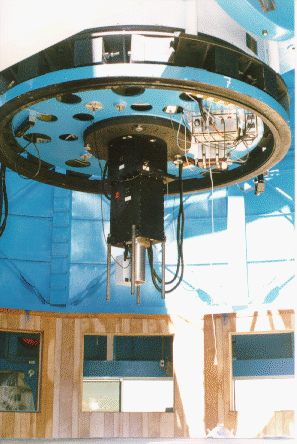Espectrophometres LFOSC
It is a very versatile instrument, which allows direct imaging and spectroscopy multiobjective. Photometry is performed in band B and V Johnson, R and R of Cousin and the transition of H-Alpha. You can obtain long-slit spectra of low resolution. The scale of plaque is one second of arc, with a field of view of 6x10 minutes of arc

Part of the information on this page is being checked. Please contact rmujica@inaoep.mx before using it.
Overview
The Landessternwarte Faint Object Spectrograph and Camera (LFOSC) is a focal reducer camera that was constructed at the Landessternwarte Heidelberg, Germany. The instrument is attached to the Cassegrain focus of the telescope and allows direct CCD imaging, filter photometry, and multi-object spectroscopy. It is equipped with an EEV P8603 CCD detector (385X578 pixels, 22![]() m linear pixel size). With a 10' X 6' field of view the image scale is 1"/pixel.
m linear pixel size). With a 10' X 6' field of view the image scale is 1"/pixel.
The LFOSC was installed at the Guillermo Haro Observatory (GHO) through the project "Optical Identification of ROSAT X-ray sources" started in 1991. The description of the project and LFOSC can be found in Zickgraf et al. (1997).
For direct imaging it is possible to use Johnson B,V , Cousins R,I and H![]() filters. A limiting magnitude of 23m in R can be reached within 900s.
filters. A limiting magnitude of 23m in R can be reached within 900s.
For the spectroscopic observations it is possible to used masks with circular holes of 3" projected diameter in the focal plane of the telescope. These masks can be produced directly from the CCD images using a computer controlled drilling device. In addition to the object holes each mask contains holes producing spectra of the sky background near the objects. Alternatively, a slit mask can be inserted in order to perform normal long slit spectroscopy. The spectra are oriented in E-W direction.
Two different grisms giving reciprocal linear dispersions of 250Å/mm and 360Å/mm, respectively, are available. For the position of the long slit, the spectral intervals covered are 4000-7200 Å and 4200-8800 Å, respectively. With a hole diameter of 3" the spectral resolution ![]() is about 13 Å and 18 Å, respectively, i.e. a resolving power of
is about 13 Å and 18 Å, respectively, i.e. a resolving power of ![]() at central wavelengths.
at central wavelengths.
Tests showed that with these standard stars a spectral classification with an accuracy of better than 5 subclasses can be obtained for objects brighter than about V= 19m with 40min exposure time. Therefore, even the optically faintest X-ray luminous coronal emitters in the, INAOE-LSW project, subsample were identified with LFOSC. Counterparts with emission lines, as e.g. AGN, can be identified as faint as to V=21m.
The layout of LFOSC is shown below.

Address: Luis Enrique Erro # 1, Tonantzintla, Puebla, Mexico ZIP Code. 72840 Tel: (222) 266.31.00 Contact: difusion@inaoep.mx
This work is licensed under a Creative Commons License Attribution-Noncommercial-No Derivative Works 2.5 Mexico.


